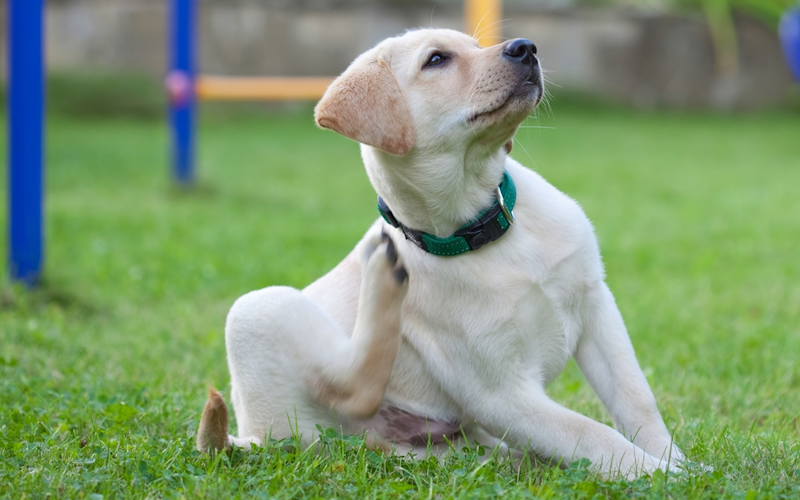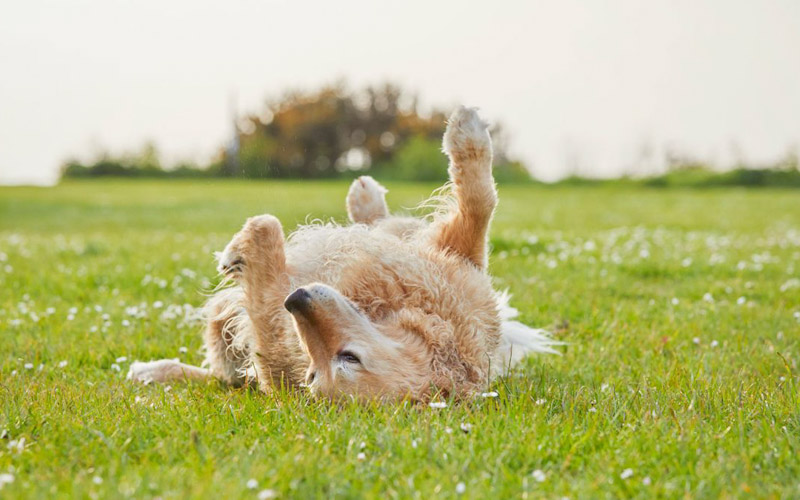If your dog loves to roll around in the grass, you may have noticed some signs of discomfort or irritation afterwards. Your dog may be scratching, licking, or chewing their skin, or showing signs of redness or hair loss. These could be symptoms of a dog grass allergy, a common condition that affects many dogs.

A dog grass allergy is an allergic reaction to the pollen or other substances found in grass. It can cause inflammation and itching of the skin, ears, eyes, and nose. Some dogs may also develop respiratory problems, such as sneezing, coughing, or wheezing. A dog grass allergy can affect any breed, age, or gender of dog, but some breeds are more prone to it than others.
In this article, we will explain what causes a dog grass allergy, how to diagnose it, how to treat it, and how to prevent it. We will also provide some tips on how to make your dog more comfortable and happy in the grass.
Symptoms
The symptoms of a dog grass allergy can vary depending on the severity of the reaction and the type of grass. However, some of the most common symptoms are:
- Itching: Your dog may scratch their skin, ears, eyes, or nose excessively, which can lead to wounds, infections, or scabs.
- Licking: Your dog may lick their paws, legs, or belly constantly, which can cause irritation, dryness, or discoloration of the fur.
- Chewing: Your dog may chew their skin, fur, or nails, which can cause pain, bleeding, or damage to the teeth.
- Redness: Your dog may have red or inflamed skin, ears, eyes, or nose, which can indicate inflammation or infection.
- Hair loss: Your dog may lose patches of fur, especially on the areas that come into contact with the grass, such as the belly, legs, or paws.
These symptoms can be very uncomfortable and distressing for your dog, and can affect their quality of life. If left untreated, a dog grass allergy can also lead to secondary problems, such as bacterial or fungal infections, ear infections, or hot spots.
Causes
A dog grass allergy is caused by an overreaction of the immune system to the grass or its components. The immune system normally protects the body from harmful substances, such as bacteria or viruses. However, in some dogs, the immune system mistakenly identifies grass as a threat and produces antibodies to fight it. These antibodies trigger the release of histamine and other chemicals, which cause the symptoms of an allergic reaction.

The most common cause of a dog grass allergy is the pollen that is released by the grass during certain seasons, especially spring and summer. Pollen is a fine powder that contains the male reproductive cells of plants. It can be carried by the wind or by insects, and can land on your dog’s skin, fur, or nose. Some dogs are allergic to specific types of grass pollen, such as Bermuda, Timothy, or Rye, while others are allergic to any kind of grass pollen.
Another cause of a dog grass allergy is the contact with other allergens that may be present in the grass, such as mold, dust mites, or insect bites. These allergens can also trigger an immune response in your dog, and can worsen the symptoms of a grass allergy.
A dog grass allergy can also be influenced by genetics. Some breeds are more likely to develop a grass allergy than others, such as Golden Retrievers, Labrador Retrievers, West Highland White Terriers, or Poodles. This may be due to inherited factors that affect the immune system or the skin barrier.
Diagnosis
If you suspect that your dog has a grass allergy, you should consult your veterinarian for a proper diagnosis. Your veterinarian will perform a physical examination of your dog, and ask you about their history, symptoms, and exposure to grass. Your veterinarian may also perform some tests to confirm the diagnosis, such as:
- Blood test: A blood test can measure the level of antibodies that your dog has against grass or other allergens. A high level of antibodies can indicate an allergic reaction.
- Skin test: A skin test can identify the specific allergens that your dog is allergic to. A small amount of each allergen is injected under the skin of your dog, and the reaction is observed after a few minutes. A positive reaction is marked by a bump or a red spot on the skin.
These tests can help your veterinarian determine the best treatment plan for your dog, and also rule out other possible causes of your dog’s symptoms, such as parasites, infections, or hormonal disorders.
Treatment
The treatment of a dog grass allergy depends on the severity and frequency of the symptoms, and the type of grass that your dog is allergic to. The main goals of the treatment are to reduce the inflammation and itching, to prevent secondary infections, and to avoid or minimize the exposure to grass. Some of the treatment options are:
- Avoidance of grass: The best way to treat a dog grass allergy is to avoid or limit the contact with grass as much as possible. This may mean keeping your dog indoors during the peak pollen seasons, or choosing areas with less grass or different types of grass for your dog’s walks or playtime. You can also use protective clothing, such as boots or jackets, to cover your dog’s skin and fur when they are in the grass. You should also wipe your dog’s paws, legs, and belly with a damp cloth or a hypoallergenic wipe after they come back from the grass, to remove any pollen or allergens that may have stuck to them.
- Medication: Your veterinarian may prescribe some medication to help your dog cope with the symptoms of a grass allergy. These may include antihistamines, corticosteroids, or immunosuppressants, which can reduce the inflammation and itching, and block the immune response. However, these medications may have some side effects, such as drowsiness, increased thirst, weight gain, or increased susceptibility to infections, so they should be used with caution and under your veterinarian’s supervision.
- Bathing: Bathing your dog regularly with a mild, hypoallergenic shampoo can help soothe their skin and remove any allergens that may have accumulated on their fur. You should use lukewarm water and avoid rubbing or scratching your dog’s skin. You can also use a conditioner or a moisturizer to hydrate and protect your dog’s skin. You should avoid using human shampoos, perfumes, or other products that may irritate your dog’s skin or cause an allergic reaction.
- Supplements: Some supplements can help your dog’s skin and immune system, and reduce the symptoms of a grass allergy. These may include omega-3 fatty acids, which can reduce inflammation and improve the skin barrier, or probiotics, which can balance the gut flora and support the immune system. You should consult your veterinarian before giving any supplements to your dog, and follow the recommended dosage and frequency.

Prevention
While a dog grass allergy cannot be cured, it can be prevented or managed with some measures. These include:
- Keeping your dog’s coat clean: A clean coat can prevent the accumulation of allergens and reduce the risk of infections. You should brush your dog’s fur regularly, especially after they have been in the grass, and trim any excess hair that may trap allergens or moisture. You should also check your dog’s ears, eyes, and nose for any signs of irritation or discharge, and clean them gently with a cotton ball or a soft cloth.
- Avoiding areas with high pollen counts: You can check the local pollen forecast and avoid taking your dog to areas with high levels of grass pollen, especially during the morning and evening hours, when the pollen is more abundant. You can also choose areas with less grass or different types of grass, such as artificial turf, gravel, or wood chips, for your dog’s outdoor activities.
- Using a HEPA air filter in your home: A HEPA (high-efficiency particulate air) filter can remove up to 99.97% of the airborne particles, including pollen, dust, mold, and pet dander, that may trigger or worsen your dog’s grass allergy. You can use a HEPA filter in your home, especially in the rooms where your dog spends most of their time, such as the bedroom or the living room. You should also vacuum and dust your home regularly, and wash your dog’s bedding and toys frequently, to eliminate any allergens that may have settled on them.
Conclusion
A dog grass allergy is a common condition that can cause discomfort and distress to your dog. It is caused by an overreaction of the immune system to the grass or its components, and can result in symptoms such as itching, licking, chewing, redness, or hair loss. A dog grass allergy can be diagnosed by your veterinarian, and treated with various options, such as avoidance of grass, medication, bathing, or supplements. You can also prevent or manage a dog grass allergy by keeping your dog’s coat clean, avoiding areas with high pollen counts, and using a HEPA air filter in your home.
If you think your dog may have a grass allergy, you should speak to your veterinarian as soon as possible, and follow their advice and recommendations. Your veterinarian can help you find the best treatment plan for your dog, and improve their quality of life. With proper care and attention, your dog can enjoy the grass without suffering from an allergic reaction.
